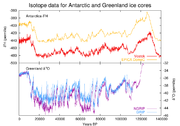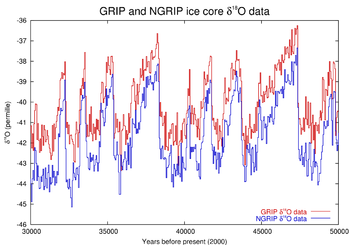
Dansgaard-Oeschger event
Encyclopedia

Willi Dansgaard
Willi Dansgaard was a Danish paleoclimatologist. He was Professor Emeritus of Geophysics at the University of Copenhagen and a member of the Royal Danish Academy of Science and Letters, the Royal Swedish Academy of Sciences, the Icelandic Academy of Sciences, and the Danish Geophysical Society.-...
–Oeschger
Hans Oeschger
Professor Hans Oeschger was the founder of the Division of Climate and Environmental Physics at the Physics Institute of the University of Bern in 1963 and director until his retirement in 1992....
events (often abbreviated D–O events) are rapid climate fluctuations that occurred 25 times during the last glacial period. Some scientists (see below) claim that the events occur quasi-periodically with a recurrence time being a multiple of 1,470 years, but this is debated. The comparable climate cyclicity during the Holocene
Holocene
The Holocene is a geological epoch which began at the end of the Pleistocene and continues to the present. The Holocene is part of the Quaternary period. Its name comes from the Greek words and , meaning "entirely recent"...
is referred to as Bond event
Bond event
Bond events are North Atlantic climate fluctuations occurring every ≈1,470 ± 500 years throughout the Holocene. Eight such events have been identified, primarily from fluctuations in ice-rafted debris. Bond events may be the interglacial relatives of the glacial Dansgaard–Oeschger events, with a...
s.
Evidence
The best evidence for Dansgaard–Oeschger events remains in the Greenland ice coresGreenland Ice Sheet Project
The Greenland Ice Sheet Project was a decade-long project to drill ice cores in Greenland that involved scientists and funding agencies from Denmark, Switzerland and the United States. Besides the U.S. National Science Foundation, funding was provided by the Swiss National Science Foundation and...
, which only go back to the end of the last interglacial, the Eemian interglacial
Eemian interglacial
The Eemian was an interglacial period which began about 130,000 years ago and ended about 114,000 years ago. It was the second-to-latest interglacial period of the current Ice Age, the most recent being the Holocene which extends to the present day. The prevailing Eemian climate is believed to...
. Ice core evidence from Antarctic cores suggests that the Dansgaard–Oeschger events are related to the so-called Antarctic Isotope Maxima by means of a coupling of the climate of the two hemispheres, the Bi-polar Seesaw. If this relationship holds also for the previous glacials, Antarctic data suggest that D-O events were present in previous glacial periods as well.
Effect
In the Northern HemisphereNorthern Hemisphere
The Northern Hemisphere is the half of a planet that is north of its equator—the word hemisphere literally means “half sphere”. It is also that half of the celestial sphere north of the celestial equator...
, they take the form of rapid warming episodes, typically in a matter of decades, each followed by gradual cooling over a longer period. For example, about 11,500 years ago, averaged annual temperatures on the Greenland icepack warmed by around 8°C over 40 years, in three steps of five years (see, Stewart, chapter 13), where a 5°C change over 30-40 years is more common.
Heinrich event
Heinrich event
Heinrich events, first described by marine geologist Hartmut Heinrich, occurred during the last glacial period, or "ice age". During such events, armadas of icebergs broke off from glaciers and traversed the North Atlantic. The icebergs contained rock mass eroded by the glaciers, and as they...
s only occur in the cold spells immediately preceding D-O warmings, leading some to suggest that D-O cycles may cause the events, or at least constrain their timing.
The course of a D-O event sees a rapid warming of temperature, followed by a cool period lasting a few hundred years. This cold period sees an expansion of the polar front
Polar front
In meteorology, the polar front is the boundary between the polar cell and the Ferrel cell in each hemisphere. At this boundary a sharp gradient in temperature occurs between these two air masses, each at very different temperatures....
, with ice floating further south across the North Atlantic ocean.
Causes
The processes behind the timing and amplitude of these events (as recorded in ice coreIce core
An ice core is a core sample that is typically removed from an ice sheet, most commonly from the polar ice caps of Antarctica, Greenland or from high mountain glaciers elsewhere. As the ice forms from the incremental build up of annual layers of snow, lower layers are older than upper, and an ice...
s) are still unclear. The pattern in the Southern Hemisphere
Southern Hemisphere
The Southern Hemisphere is the part of Earth that lies south of the equator. The word hemisphere literally means 'half ball' or "half sphere"...
is different, with slow warming and much smaller temperature fluctuations. Indeed, the Vostok ice core was drilled before the Greenland cores, and the existence of Dansgaard–Oeschger events was not widely recognised until the Greenland (GRIP
Greenland ice core project
The Greenland Ice Core Project was a multinational European research project, organised through the European Science Foundation. Funding came from 8 nations , and from the European Union...
/GISP
Greenland Ice Sheet Project
The Greenland Ice Sheet Project was a decade-long project to drill ice cores in Greenland that involved scientists and funding agencies from Denmark, Switzerland and the United States. Besides the U.S. National Science Foundation, funding was provided by the Swiss National Science Foundation and...
2) cores were done; after which there was some reexamination of the Vostok core to see if these events had somehow been "missed".

The events may be caused by an amplification of solar forcings, or by a cause internal to the earth system - either a "binge-purge" cycle of ice sheets accumulating so much mass they become unstable, as postulated for Heinrich event
Heinrich event
Heinrich events, first described by marine geologist Hartmut Heinrich, occurred during the last glacial period, or "ice age". During such events, armadas of icebergs broke off from glaciers and traversed the North Atlantic. The icebergs contained rock mass eroded by the glaciers, and as they...
s, or an oscillation in deep ocean currents (Maslin et al.. 2001, p25).
Timing
Although the effects of the Dansgaard–Oeschger events are largely constrained to ice cores taken from Greenland, there is evidence to suggest D-O events have been globally synchronous. A spectral analysis of the American GISP2 isotope record showed a peak of [18O:16O] abundance around 1500 years. This was proposed by Schulz (2002) to be a regular periodicity of 1470 years. This finding was supported by Rahmstorf (2003); if only the most recent 50,000 years from the GISP2 core are examined, the variation of the trigger is ±12% (±2% in the 5 most recent events, whose dates are probably most precise). However the older parts of the GISP2 core do not show this regularity, nor do the same events in the GRIP core. This may be because the first 50 kyr of the GISP2 core are most accurately dated, by layer counting. The climate system response to the trigger is varying within 8% of the period. Oscillations within the Earth system can be expected to be far more irregular in period. Rahmstorf suggests that the highly regular pattern would point more to an orbital cycle. Such a source has not been identified. The closest orbital cycle, a Lunar cycle of 1,800 years, cannot be reconciled with this pattern. The dating between the European GRIP ice coreand the American GISP2 ice core differs by about 5000 years at 50,000 years BP. It was noted by Ditlevsen et al. (2005) that the spectral peak found in the GISP2 ice core was not present in the GRIP core, and thus depended critically on the accuracy of the dating. The dating issue was largely solved by the accurate dating of the NGRIP core. Using this dating the recurrence of Dansgaard–Oeschger events is random consistent with a noise induced Poisson process.
D-O cycles may set their own timescale. Maslin et al.. (2001) suggested that each ice sheet had its own conditions of stability, but that on melting, the influx of freshwater was enough to reconfigure ocean currents - causing melting elsewhere. More specifically, D-O cold events, and their associated influx of meltwater, reduce the strength of the North Atlantic Deep Water current (NADW), weakening the northern hemisphere circulation and therefore resulting in an increased transfer of heat polewards in the southern hemisphere. This warmer water results in melting of Antarctic ice, thereby reducing density stratification and the strength of the Antarctic Bottom Water current (AABW). This allows the NADW to return to its previous strength, driving northern hemisphere melting - and another D-O cold event.
This theory may also explain Heinrich events' apparent connection to the D-O cycle; when the accumulation of meltwater in the oceans reaches a threshold, it may have raised sea level enough to undercut the Laurentide ice sheet - causing a Heinrich event and resetting the cycle.
The little ice age
Little Ice Age
The Little Ice Age was a period of cooling that occurred after the Medieval Warm Period . While not a true ice age, the term was introduced into the scientific literature by François E. Matthes in 1939...
of ~400 to 200 years ago has been interpreted by some as the cold part of a D-O cycle.
History
The ice core's signals now recognised as Dansgaard–Oeschger events are, in retrospect, visible in the original GISPGreenland Ice Sheet Project
The Greenland Ice Sheet Project was a decade-long project to drill ice cores in Greenland that involved scientists and funding agencies from Denmark, Switzerland and the United States. Besides the U.S. National Science Foundation, funding was provided by the Swiss National Science Foundation and...
core, as well as the Camp Century Greenland core http://www.ncdc.noaa.gov/paleo/icecore/greenland/gisp/campcentury/campc.html. But at the time the ice cores were made, their significance was noted but not widely appreciated. Dansgaard et al. (AGU geophysical monograph 33, 1985) note their existence in the GRIP core as "violent oscillations" in the δ18O signal, and that they appear to correlate to events in the previous Camp Century core 1 400 km away, thus providing evidence for their corresponding to widespread climatic anomalies (with only the Camp Century core, they could have been local fluctuations). Dansgaard et al. speculate that these may be related to quasi-stationary modes of the atmosphere-ocean system. D-O Events tend to be what drives the "Sahara pump
Sahara pump theory
The Sahara pump theory is a hypothesis that explains how flora and fauna migrated between Eurasia and Africa via a Levantine land bridge. The theory observes that extended periods of abundant rainfall lasting many thousands of years in Africa are associated with a "wet Sahara" phase, during which...
" which has had an effect upon human evolution and dispersal.
The cyclicity is also found during the Holocene, where the events are referred to as Bond events.
External links
- Introduction to Physical Oceanography by Robert H. Stewart
- http://content.aip.org/products/esva/Dansgaard_Willi.html (subcription required) - Photo of Dansgaard and Oeschger in a sub ice trench at Dye-3

